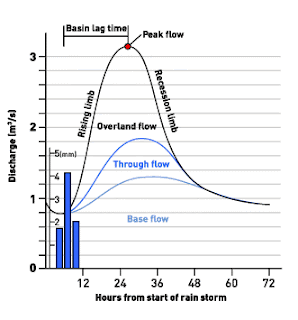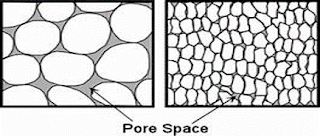THE INTERNAL STRUCTURE OF EARTH
The direct observation of the interior of the earth is not possible as the interior becomes hotter with increasing depth. Much of our knowledge about internal structure of the Earth is revealed primarily by seismic waves (compressional P-wave and Shear S-wave) generated from the earthquake.
The seismic wave velocities vary with pressure (depth), temperature, mineralogy, chemical composition and degree of partial melting.

A sudden change in seismic wave velocity at a seismic discontinuity indicates the change physical and chemical properties of material inside the earth.
Discontinuity which lies between crust and mantle at depth of ~70 Km is Mohorovicic discontinuity.
Gutenberg's discontinuity lies between the mantle and the core at depth ~2885 Km.
Between the inner and outer core, the Lehmann discontinuity occurs about ~5155Km depth.
The division of Earth layers on the basis of its physical and chemical properties: -
3- Outer core: - Outer core did not transmit S-wave that's why the outer core is interpreted to be liquid (S-wave do not travel through liquid) extended from 2900 km to 5200 Km.
4- Inner core: - Inner core extends from 5200Km to 6378Km (the center of the Earth) transmits S-wave at Very low velocity suggest that it is nearly at melting point.
There is only two layers in Eath with low seismic velocity gradient; LVZ at the base of the lithosphere and D" layer just above the core. These layers coincide with a very steep temperature gradient and hence are the thermal boundary layer within the earth. the LVZ is important in that plates which are disconnected from the mantle at this layer. Plate tectonics could not exist without an LVZ.
The D" layer is important in that it may be the site at which mantle plume is generated.

A sudden change in seismic wave velocity at a seismic discontinuity indicates the change physical and chemical properties of material inside the earth.
Discontinuity which lies between crust and mantle at depth of ~70 Km is Mohorovicic discontinuity.
Gutenberg's discontinuity lies between the mantle and the core at depth ~2885 Km.
Between the inner and outer core, the Lehmann discontinuity occurs about ~5155Km depth.
The division of Earth layers on the basis of its physical and chemical properties: -
1- Crust:- The Earth crust is the upper solid shell of a planet the base of which is defined by a prominent seismic discontinuity, the Mohorovicic discontinuity and range in thickness from ~3Km at some oceanic ridge to ~70Km in collisional orogeny.
2- Mantle:- It extends from moho discontinuity to 2900Km (the core-mantle boundary). The mantle is divided into two layers as follow:-
*Upper Mantle:- Extend from Moho to 660 Km discontinuity. It includes the lower part of the lithosphere and upper part of the asthenosphere, the region from the 410Km to 660Km discontinuities is known as the transition zone. These two discontinuities at 410Km and 660Km are caused by two important solid-state transformations from olivine to wadsleyite at 410Km.
Lithosphere:- It includes the crust and the brittle portion of the upper mantle. It is a rigid portion of Earth. The most well-known feature of the lithosphere is its tectonic activity (mobile property). The lithosphere is divided into 15 major tectonic plates. This tectonic activity of the lithosphere is promoted by asthenosphere which consists of plastic material.
Asthenosphere:- The asthenosphere extending from the base of the lithosphere to the 660 Km discontinuity is by compression of the weak layer that readily deforms by creep. A region of low seismic wave velocities and high attention (weakening) of seismic wave energy.
The low-velocity zone (LVZ) occurs at the top of the asthenosphere and is from 50-100Km. Significantly the lateral variations in density and in seismic wave velocities are common at depth of less than 400Km. The top of the LVZ is generally assumed to make the base of the lithosphere.
*Lower Mantle:- Extend from the 660Km discontinuity to 2900 Km discontinuity at the core-mantle boundary. For the most part, it is characterized by a rather constant increase in velocity and density in response to increasing hydrostatic compression.
Between 220-250Km above the core-mantle interface, a flattening of velocity and density gradients occurs in a region known as the D" layer. Because of the diffraction of the seismic wave by the core, the resolution of this layer is poor and thus details of its structure are not well known. The lower mantle is also referred to as the mesosphere. A region that is strong (solid) but relatively passive in terms of deformation processes.3- Outer core: - Outer core did not transmit S-wave that's why the outer core is interpreted to be liquid (S-wave do not travel through liquid) extended from 2900 km to 5200 Km.
4- Inner core: - Inner core extends from 5200Km to 6378Km (the center of the Earth) transmits S-wave at Very low velocity suggest that it is nearly at melting point.
There is only two layers in Eath with low seismic velocity gradient; LVZ at the base of the lithosphere and D" layer just above the core. These layers coincide with a very steep temperature gradient and hence are the thermal boundary layer within the earth. the LVZ is important in that plates which are disconnected from the mantle at this layer. Plate tectonics could not exist without an LVZ.
The D" layer is important in that it may be the site at which mantle plume is generated.





Comments
Post a Comment